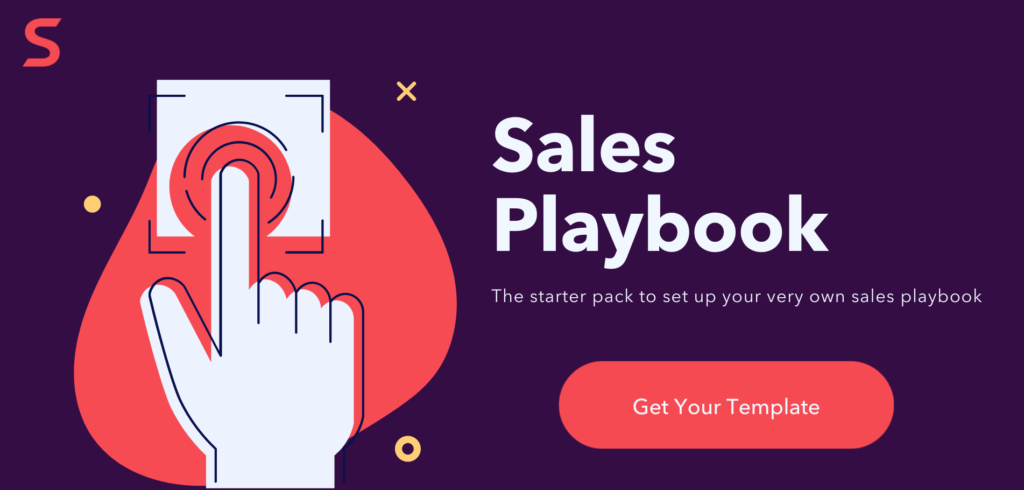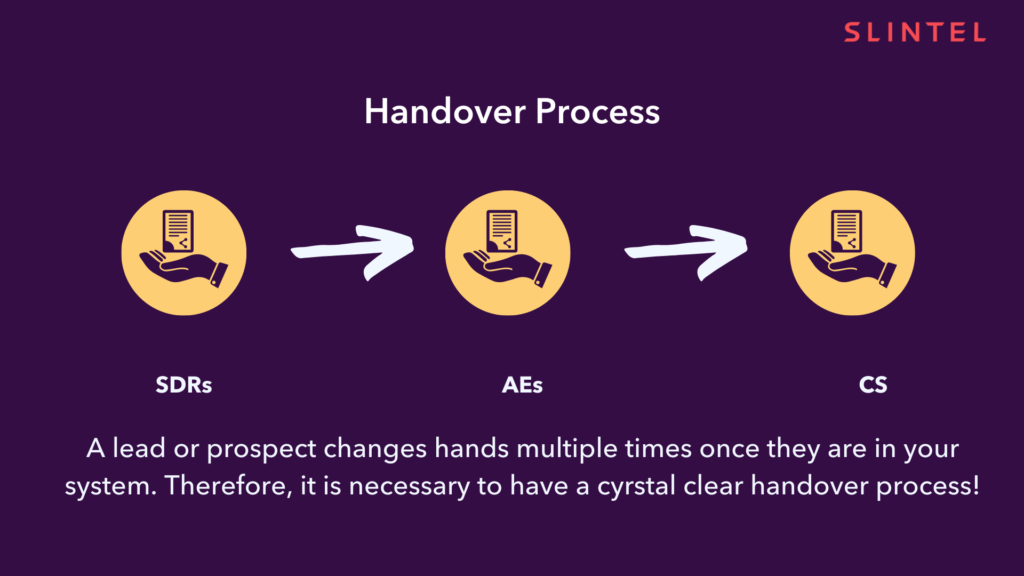What do the New England Patriots, Pittsburgh Steelers, Green Bay Packers and Slintel have in common?
A kick-ass playbook.
Whether you are a football team or a sales team, you need a playbook with all the plays needed to achieve your “goal”.
Let us take a look at some of the best sales playbook examples.
We’ve created a template that you can use to build your own sales playbook here!
Keep this template open on another window while you read the rest of this blog post to create your sales playbook in an easy, step-by-step manner.

What is a sales playbook?
A sales playbook is a bible (of sorts) to maintain best practices, sales techniques, tactics, and strategies that are employed during different stages of the sales cycle. It is a document that guides sales reps on what to do in specific situations, such as during prospecting, nurturing, or pitching.
Typically, a sales playbook includes sales methodologies, detailed sales process and elaborate resources such as sales prospecting email templates, objection handling, call scripts, buyer personas, ideal customer profiles and common customer pain points and more into one interconnected symphony.
What’s inside a sales playbook?
Have you heard of the phrase “devil is in the details”?
Well, the sales playbook is where this must be implemented. By this, I mean that your playbook must contain a plan or process outlined to the last minute detail.
Any scenario you potentially think your sales teams could face, your playbook should contain solution(s) to counteract it.
Some of the best sales playbooks include:
- Sales Resources Hub
- Defined Buyer Personas
- Training Schedules
- Sales Tools
- Pricing
- Interrogations of Sales War: Who, What, When, Where & Why
- Team Processes
- Handovers
- Demo Flows
- Objection Handling
Breaking down your all encompassing sales playbook into bite sized playbooks for specific teams or specific products is the best way to start putting your playbook together. Going about it this way would be more easier than trying to tackle the entire sales playbook at once. would be more helpful.
Dig deeper into this blog to find what each section contains in detail along with examples. If you do manage to finish reading this blog, consider yourself equipped to create a sales playbook for yourself. This blog is packed with examples, suggestions and more all designed to equip you to start creating a sales playbook for your team.
1. Sales Resources Hub
If your sales playbook is the pasta, then your sales resources hub is the secret sauce that brings out all the flavors in your sales playbook.
Your sales playbook resource hub incorporates the following:
- Sales Presentations
- Frequently Asked Questions
- Miscellaneous Resources
Disclaimer: This is not an exhaustive list and could differ from each company to each team to each product or service for which you are creating your playbook for.
Let’s dive into each of these resources in detail.
A. Sales Presentations
This is one item in your sales resource hub that you can’t live without. Sales presentations are quintessential for your sales teams to spotlight who they are, what they do, which customers they have on board, and most importantly the potential customers they will serve in the future.
Get the best brains of your company together to curate top-notch sales decks that will ideally allow your sales reps to nail their demos, discovery and closing calls.
There are different ways to arrange your sales presentations. One is to classify them based on the sales funnel stages: early, middle and late, another is to have sales presentations for specific target buyer personas, pricing points, specific products or services, or different use-cases.
B. Frequently Asked Questions
If you are a sales manager with multiple sales teams to oversee, then this section can come to your rescue.
Incorporating all the “what to do if scenarios” that every sales rep will inevitably face will help you save some time fielding these kinds of questions. This will also maintain standardization across your sales teams.
For Example: This section could outline what constitutes as an opportunity (lead qualification process), what email templates to use when a lead is in different opportunity stages, or what are the different stages of opportunities, or who you should reach out to if you need other resources not identified in the playbook and more.
C. Miscellaneous Resources
This section is to hold resources that don’t fit anywhere else. These could be calls with your prospects or customers, handover instructions, slack channels to join, team dashboards, extensions, login credentials, sales enablement resources trackers and more.
2. Processes
What do sales teams and factories need to have in common? A precise assembly line process.
Sales teams without precise processes in place are often the cause for pandemonium.
Within your sales playbook, outlining the following processes is a must:
- Selling Process
- Invoicing and Contracting
- Handover
- Forecasting
A. Selling Process
The biggest reason why your playbook exists is for this purpose. Setting up and outlining your sales process. A top-level sales process should have multiple touchpoints and room for customization and pliability. A sales process can look something like this –

A strong sales process will benefit you in the long run. With it:
- You can achieve consistency throughout your sales teams
- Your sales reps can bank on it to develop a flow in their sales calls
- Will allow sales managers to track what is working and what is not.
B. Invoices & Contracts
What are the pricing plans you offer? Annual? Monthly? Or an installment plan? Can your customers pay upfront in full or do you expect the payments to come in every quarter?
Do you offer any discounts? If so, what are they? What are the situations in which these discounts can be applied and whose sign off is required? Standardizing contract processes will dispel the guesswork your sales reps would have to do otherwise.
Similarly with the invoicing process, you need to define what your invoice number looks like, who has the signatory authority to sign off on these invoices. Having separate templates for annual, monthly, quarterly payments is a must.
Hosting all these templates in one place makes it easier for your sales reps to find it and dispense the same.
C. Handover Process
An opportunity that enters the sales cycle passes through many hands. From SDRs to AEs to CS teams and more. Therefore, a structured handover process is required.
Handover processes can be tricky and tedious (because there are a lot of reiterations of information).
Efficient handover processes are the best way to let your customers know that you hear them, and that you have the entire team working in tandem to provide solutions.

D. Forecasting Process
Sales forecasting allows you to estimate future revenue that can be generated by your sales teams for the next month, quarter or year. Your forecasting can be derived from historical data, industry trends and the state of your current sales pipeline.
A good forecasting should allow managers to make better decisions about hiring, budgeting or goal-setting so that their sales teams can start to work more efficiently and close bigger deals.
Including a sales forecasting process in your playbook will get your sales teams to focus on how the company has done before and how it will fare in the future.
Other advantages include, documenting the process, reasonable goals and expectation settings, identifying your benchmark sales metrics, assessing the health of your sales pipeline, and more.
3. Interrogations of Sales War: Who, What, When, Where & Why
In war “interrogation” or asking who, what, when, where and why is very important to create directives that soldiers use to engage with the enemy.
In sales however, these interrogations allow you to create a guideline on how your sales teams can act and interact so that there is no room for debate on what is the appropriate reaction to a particular situation.
With this one can focus on setting up your pipeline for the upcoming month, quarter or even the year, ensure that more deals are closed, generate higher revenues, and more.
More specifically these allow your sales teams to:
- Identify how many touch points each account requires
- Direct accounts to the right teams
- Develop an efficient manner to engage with accounts
- Resolve conflict
- Share information
- Coordinate handovers
Now the question arises, where can this be applied? Well, at the least these need to be in play when defining segments, territories and accounts.
A. Segments
What are the different segments in your total addressable market (TAM)? How many segments are present? What criteria’s are used to place a buyer in one segment as opposed to another? Is there a possibility that a future customer might be a part of two distinct segments. If so, what are the scenarios in which this can happen?
B. Territories
How is a territory defined? Is it based on zip code, country or region? Which sales teams focus on which territories? Who are the sales reps handling each territory?
C. Accounts
Who has the ownership of each account? What are the different types of accounts your sales teams handle? Who has the responsibility of each account? Is it your SDRs or your AEs? What defines an account? What qualifying process is to be used when determining an account? How is your handover process for each account defined?
And more. Answering these questions and more determines how intricately you have defined your sales strategies and in net effect close more deals and increase the revenue generated.
4. Pricing
Now we have arrived at the most important part of your sales playbook. Pricing.
Any sales playbook, missing this section is a colossal fail. No sales teams can function without defining this crucial aspect.
While there is no one size fits all for your pricing strategy, it is important to define it. Regardless of where your pricing sheet will exist (on your website or shared with prospects at a particular touch point) it is important to define it and create documentation for the same.
The reason for this is simple: avoid confusion and maintain consistency.
There are two distinct pieces of information that need to be created for this section.
A. Pricing Sheet
This can be a single sheet which outlines the different price tiers your organization uses or can be a multi page sheeter that outlines what price points you can sell your product/services at.
Your pricing sheet can be publicly available, or kept private or some aspects of publicly accessible with custom pricing language present.
While the decision is dependent upon your company’s policies on what type of pricing strategy is to be used, however, a pricing sheet is a must and needs to be regularly updated to reflect inflation, new products/services offered etc.
B. Pricing Conversations
This section talks about how you go about introducing the pricing to your leads or prospects. Do you lead with this or do you wait to have this talk at a certain stage of your overall conversation? Or do you use a mix of these options?
Include the best pricing conversations some of your top reps have had so that everyone in your sales teams can access it to learn more about how to talk about “price”.
One of the ways you can approach this is by discussing price during discovery calls!
5. Templates: The Best Sales Playbook Examples
A sales playbook is far from complete, if there is no easy access to templates and the best sales playbook examples used by your sales teams on a day to day basis.
Therefore, think of templates (think of branded, assessed and plan of attack) as irreplaceable pieces of your sales toolbox.
Based on how you and your sales teams develop them, templates can be used as is or customized to fit a situation.
Some of the most important templates to include in your sales playbook are:
A. Email Templates
After the discovery and demo calls, your sales teams spend significant time sending emails to their prospects.
One way to reduce time spent on this is by setting up email templates your sales teams can access on the go.
Identify the scenarios in which your sales teams need email outreach. Develop a template that can be easily modified to fill the details of a prospect.
This will reduce time spent by sales reps drafting each single email and will also ensure consistency and increase productivity.
Some of the situations for which email templates are required can be as follows:
- Emails for cold, warm and hot leads
- Post discovery and demo emails
- Trial set up emails
- Speed-up closing dates emails
While this list is not exhaustive, the scenarios could potentially be endless.
At first this task may seem time consuming and requires a lot of effort, but remind yourself of the time your sales teams will save with these handy and accessible email templates.
Here are some examples of email templates that you can use.
- Post discovery email template:
Hey {insert first name here},
It was great talking to you and the team today to understand what your requirements are with our product.
Below is a snippet of all the ways {insert your product name here} is aligned with your needs.
[Include all the ways your product helps prospects to solve for their pain points here]
Here’s some validation and love from our customers-
[Insert relevant customer stories for your prospects specific use case here.]
As next steps-
[Insert the next steps here. Example: setting up time for demo if that has not been covered on discovery; involving more stakeholders; getting some information before the demo from the prospect.]
Looking forward to demonstrating the platform to you on {date of next call}.
Talk soon/ Regards/Best/Cheers (Or any other end call sign that you use)
{insert sales rep signature here}
- Post demo email template
Hey {Team/first name},
It was great catching up with {you/ your team} today!
We discussed that {insert product name here} can help you and your team achieve the following goals-
[Insert all the different ways your product can help the prospect].
Here’s what our raving customers have achieved
[Add some stats that similar prospects have shared with you for this particular use case.]
[Insert all the questions you have for your prospect, such as pricing points they are considering, or timelines, or other decision makers that need to sign off the solution you are offering, etc.]
Looking forward to learning the next steps from you.
Talk soon,
{insert sales rep signature here}
B. Sales Decks
Next up is sales decks. No matter the type of sales deck (powerpoint, PDFs or Google presentations, Canva) you use, the sales playbook should include them all.
These decks are the starting points that can be used in discovery calls, demos or simply be a means of sharing information on what your product or service is.
Sales decks are usually drafted by the higher-ups who have a detailed understanding of what needs to be included in it.
Like any other template, these decks need to be updated regularly to reflect new features, logo changes, reflect the right metrics, include relevant case studies and more.
Some of the aspects of sales decks can be customizable, if your sales teams are using them for a particular company.
If so, you can create areas in the deck that allow sales reps to add information on how your product/service can be helpful for a particular prospect. They can also include the prospects logo and other such information relevant to their conversation.
6. Product Demos & Flows
Every product demo is different. While there is more than an ounce of truth to this, product demos need not be so stressful.
To avoid losing prospects or leads, sales playbooks should have everything defined. From what kind of demo deck to use to what kind of demo flow to the messaging that can be used after the demo is completed and the other touch points required to successfully convert a prospect to a customer.
For this to happen, sales playbooks should contain the following:
- Qualifying Questions
- Demo Flows
- Customer Stories
A. Qualifying Questions
The biggest difference between novice sales reps and experienced ones is that, the former just goes through the motions of the demo. They fail to discern the need to identify what the prospect is “interested” in.
An experienced rep would customize the demo to include the needs and pain points of the prospect that they have “discovered” during the discovery call. This is where qualifying questions come into play.
Qualifying questions could include: What are your pain points? What are the timelines you are looking at to implement this solution? Who are the decision makers involved in this process? What budgetary restrictions could they potentially have to implement this solution? And more.
Armed with all the answers to the above questions, an experienced sales rep will develop their demo to ensure that the prospect knows that you are listening to their concerns and working towards providing them with a solution for the same.
B. Demo Flows
While having a script for demos in your sales playbook is good practice, sales reps need to understand that this is the starting point of their demos. Demos look and feel different based on buyer personas, use cases and more. A demo pitch to a manager is different from a demo pitch to a C-level personnel.
Therefore, tweaking the demo flows present in the sales playbook is essential. Sales reps need to understand that the demo script included in the playbook is a starting point and not the end result.
C. Customer Stories
Nothing says better than customers raving about your product. Include a list of customer stories for different use cases that sales reps can use when demoing the product to their prospects.
Make sure that the list you are curating in your sales books are some of the top notch customer stories backed by relevant data.
7. Objection Handling
Objection handling is a skill that salespeople uses to ease concerns raised by prospects. Thus objections generally revolve around price, product, or competitors, or could simply be a way to brush you off.
So rather than sweeping them under the rug and ignoring them, it is better to welcome them and address them openly.
One of the ways to do this is to proactively ask questions to identify if there are objections. Some questions like:
- Do you have any trouble around ABC?
- Are there any roadblocks that would stop you from buying our product or service?
- Are you able to visualize the success you would see implementing our product or service?
- You seem a little worried about XYZ. Is there anything I can do to address your concerns?
A sales playbook must include some of the objections faced by sales reps. You can use this blog we released a few weeks ago where we talk about some of the common objections sales reps face and how to tackle them.
Final Step: Start Your Very Own Sales Playbook
There you have it, This is how a sales playbook should look like. If you have read up to this point, then kudos!
You are now equipped with all the best sales playbook examples you need to start your very own sales playbook.
Still unsure? Here is an editable sales playbook template you can use to kick start your very own.






